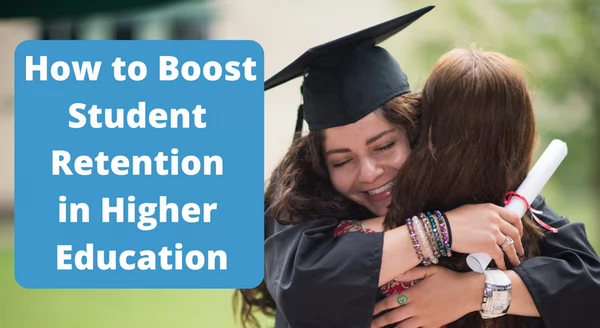
Student retention is a critical metric for the success of any school.
As colleges and universities compete for new students, retaining those students is equally crucial.
With the enrollment cliff approaching and FAFSA challenges extending recruitment well into the summer, schools must ensure their students feel supported, engaged, and happy to stay.
This article explores the complexities of student retention and why colleges should consider its importance in reaching their institutional goals.
Student retention refers to the ability of an institution to keep students enrolled from admission through to graduation.
High retention rates typically indicate a healthy educational environment, robust student support systems, and overall institutional effectiveness.
Conversely, low retention rates can signal underlying issues that need addressing to prevent student loss to other institutions or dropouts.
The following are a key reasons why student retention matters:
Personalization in higher education means creating experiences that meet each student's unique needs and preferences.
By using various strategies and tools to personalize learning, communication, and support, schools can boost student engagement and satisfaction, ultimately improving student retention — not only from the first semester to the second but through graduation.
1) Tailored Communication: Personalized communication involves sending targeted messages that resonate with students based on their demographics, interests, and behavior. For instance, emails addressing students by their first name, referencing their major, and highlighting relevant events can make them feel valued and understood.
2) Customized Learning Paths: Offering students personalized learning paths, such as elective courses, minors, or special programs that align with their career goals, helps keep them motivated and engaged. This approach can significantly reduce the likelihood of dropout due to lack of interest or perceived relevance.
3) Individualized Support Services: Providing tailored support services, such as academic advising, counseling, and career services, ensures that students receive the help they need when they need it. Personalized support can address academic struggles, personal issues, and career uncertainties, improving student satisfaction.
At Hannon Hill, we recognize the important role of personalized communication in reducing summer melt to improve student retention.
Clive, our web personalization tool, allows higher education marketers to easily create and share tailored messages across their websites.
This means students receive the right information at the right time, keeping them engaged and excited about their college journey.
Most higher education websites, especially the homepages, are geared toward recruitment, which can negatively impact the experience of existing students. Clive allows higher-ed marketers to combat this, as specific sections of a given page can be altered to better suit and serve retention.
Personalized content helps address individual concerns, answer questions, and reinforce enrollment decisions, significantly reducing the risk of summer melt.
Additionally, Clive provides detailed analytics on impressions, click-through rates, and conversions, enabling schools to refine their recruitment and retention strategies based on data-driven insights.
Explore how Wilfrid Laurier University's strategic use of web personalization in higher education marketing garnered over 2,000 sign-ups, enhancing student recruitment and engagement.
Clive seamlessly integrates with Salesforce and leverages Webhooks in our Enterprise tier, ensuring cohesive messaging and smooth data flow across all touchpoints from inquiry to graduation.
This unified communication and data management approach enhances the overall student experience, helping institutions keep students engaged, supported, and committed to their educational journey.
Social media is a powerful tool for engaging students and fostering a sense of community, which is essential for retention.
Here are some tips for leveraging social media to keep students engaged:
Stay tuned for our upcoming webinar on how to use social media to retain students through engaging short-form videos with Maya Demishkevich, Chief Marketing Officer at Carroll Community College and Rob Clark, Social Media Strategist of That Tall Family.
By leveraging personalization strategies, institutions can significantly enhance student engagement and satisfaction, leading to higher retention rates.
Additionally, an active and engaging social media presence can further strengthen the sense of community and support that is essential for keeping students enrolled and thriving.
By focusing on personalized experiences and using the right tools and strategies, higher education marketers can ensure that their institutions not only attract students but also retain them through to graduation, setting the stage for their future success.
To learn more about how Clive can help you tailor your content, request more information by filling out the form below.
Last Updated: Jun 27, 2024 11:00 AM